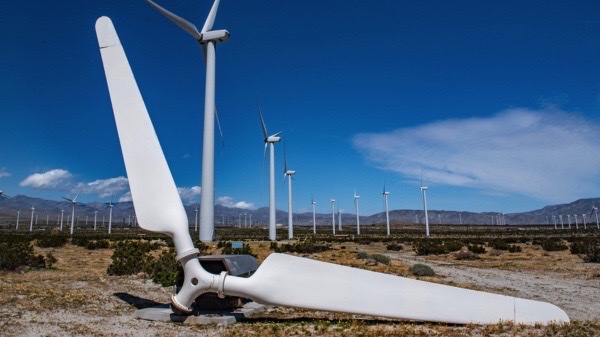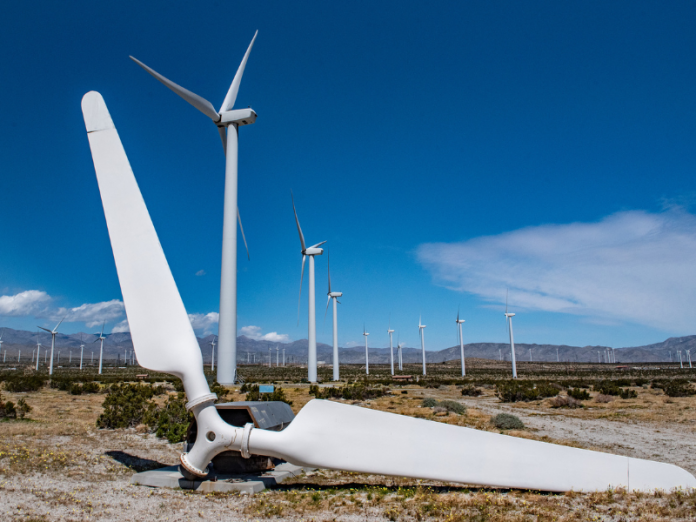YOU SHOULD SUBSCRIBE TO CLIMATE CHANGE WEEKLY.
IN THIS ISSUE:
- Physics Is Why Renewables Can’t Power Modern Economies
- Podcast of the Week: Climate Change Policy Is Making Your Life Worse
- Offshore Wind Projects Are Slaughtering Sea Birds
- Video of the Week: Embracing Petro-Masculinity
- BONUS Video of the Week: The Unreliability of Climate Measurements, Joe Bastardi
- Climate Comedy
- Recommended Sites
Miss Anything at Heartland’s Climate Conference? No Problem.
Physics Is Why Renewables Can’t Power Modern Economies

To understand why wind and solar power, even with battery backup, will not be sufficient in the near future to supply the electric power needs of any modern industrial economy, much less an economy the size of the United States, one must first understand how the electric power system works.
Note: I’m not talking about costs. Although the media regularly reports demonstrably false claims that wind and solar power are cheaper than traditional power sources such as coal, natural gas, hydroelectric, and nuclear, that’s not the issue I’m addressing today.
I’m simply discussing the physics and real-world possibility of the electric power system in the United States going net zero by 2030, 2035, 2050 or whatever random date one might project is necessary to prevent global average temperatures from exceeding the also completely random 1.5℃ to 2℃ rise commonly assumed to be the trigger for a climate disaster.
The engineers that designed modern power systems understood these realities and applied them as they developed the well-functioning systems in America and Europe that have driven economic growth for a century now. However, engineering truths are now being ignored by politicians hoping to score points with green voters. Reality matters, folks, and as wind and solar have increasingly displaced coal, the number of blackouts and brownouts across the nation has increased dramatically, more than doubling in the past six years alone. This is not a coincidence or a result of climate change.
A large-scale power grid consists of two segments: baseload power and peaking power. Baseload power is the minimum amount of energy needed for normal daily operations, which requires a fairly constant flow of power. Coal, nuclear, hydro, and to a lesser but growing extent natural gas have satisfied the country’s baseload for the past century because they operate full-time, providing a steady flow of power.
Peaking power is the additional power needed when the system is faced with unusual amounts of demand, as in July and August in Texas or Arizona, when air conditioner use soars, and in December and January in Minnesota or North Dakota, when the furnaces kick in. Natural gas has commonly served to provide peaking power because it can be cycled on and off quickly, as needed.
Neither wind nor solar can be relied upon for either baseload or peaking power. Wind turbines generate power only when the wind blows between certain speeds, and the power they generate fluctuates constantly as wind gusts vary. Solar provides no power at night or when solar panels are covered by snow or ice, and only reduced power on cloudy days, during storms, or when dirty. Battery backup, the power source that is supposed to fill the gaps when wind and solar are not producing electricity or are producing less than what is in demand, will not exist in the needed capacities for decades to come, if ever. There simply aren’t enough batteries, not enough being built, and not enough of the needed materials to build them being mined and refined, to change that anytime soon.
It is true that new technologies are being developed, such as new types of batteries and technologies to allow geothermal power to become more widespread, but they are years away from commercial practicality. They won’t make substantial additions to the electric power system on the short timelines demanded by net zero advocates.
These realities mean every megawatt of wind and solar added to the electric grid requires a megawatt of backup from traditional sources to run constantly at less-than-peak levels as spinning reserve, to regulate the flow of fluctuating power delivered to the grid from turbines and solar panels when they are operating and to take up the slack during periods when either or both sources of weather-dependent power are not operating.
Despite these realities, Democrats and climate warriors at the federal level and in the states are shutting down necessary baseload and peaking power sources as fast as they can.
The electric grid was built up over 80 years or more. To reduce carbon dioxide emissions (which are in fact beneficial to the environment), climate scolds are demanding the impossible, to replace fossil fuels with renewable power plants in just seven, 12, or for some unusually patient alarmists, 27 years.
To meet current electric power needs, estimates are millions of wind turbines would have to be erected, millions of solar panels installed, and billions of battery packs stored in millions of homes or at tens of thousands of centralized battery farms that would have to be built. Wind turbines would have to cover one-third of the continental United States, or solar panels would probably have to cover more than 20 percent of the countryside, just to meet current demand.
We would also have to erect thousands of additional electric towers, string thousands of additional miles of transmission lines, and build thousands of new transformer stations to get the power from the locations where the wind blows and sun shines regularly—which is where the wind and solar farms will have to be built, of course—to the cities and towns where the power is needed. That will have a devastating impact on wildlife and wilderness.
Of course, that’s just to meet the current demand for electric power. The U.S. population is growing, the economy is growing, and because of Biden administration regulations limiting natural gas appliances and vehicles powered by internal combustion engines, more people will be plugging in more electric vehicles, more electric stoves, more electric furnaces, more electric water heaters, etc., so demand for electricity is going to grow dramatically, meaning we will need even more turbines, panels, batteries, and transmission lines than estimated.
How big a task is the net zero transformation? On September 30, 2019, Roger Pielke Jr. calculated reaching net zero globally by 2050 would require bringing online the equivalent of three new large nuclear power plants every two days, beginning on October 1, 2019 and going on through January 1, 2050. Alternatively, hitting net zero by 2050 would require the deployment of approximately 1,500 new wind turbines covering 300 square miles of land each day from October 1, 2019 through January 1, 2050, Pielke calculated. The United States’ contribution would require one new large nuclear power plant deployed every six days or the equivalent of 1,000 wind turbines every six days, Pielke reported. Simultaneously, countries around the world would have to retire an equivalent amount of fossil fuel power along the same timelines.
In case no one has noticed, the United States hasn’t opened even a single new power plant since Pielke wrote, and although hundreds of new turbines have been erected since 2019, nowhere near the 218,000 turbines required over the 1,308 days between October 1, 2019 and May 1, 2023 have been built. And although in America some large fossil fuel power plants have been shuttered, some have also been added, so the pace of required emissions reductions in the United States, much less across the world where new coal and gas plants are being brought online at a breakneck pace, is far from being met. That means the necessary pace of power plant closures and openings of new zero-emitting power sources is steeper now than when Pielke produced his analysis three and a half years ago.
And that’s to hit net zero by 2050. To meet the much more ambitious target of net zero by 2030, as some are demanding, the United States would have had to begin deploying the equivalent of one new nuclear plant or 1,000 wind turbines every other day, starting back in 2019.
Proponents of net zero admit the technological transformation required is akin to a wartime effort. If net zero is to be accomplished, all manufacturing will have to be directed away from whatever products we build now and diverted to the production of millions of wind turbines, solar panels, electric vehicles, batteries, transmission towers and power lines, rail tracks, cars, battery packs, heat pumps, and associated technologies for the net zero economy. The government will have to conscript all factories, and by extension their workers, into a warlike net zero crusade against chimeric climate change. It would all be for naught, moreover, because global greenhouse gas emissions would continue to rise to power economic growth in developing countries that are not foolish enough to impose fossil fuel restrictions on themselves.
Energy analyst Mark Mills refers to the green energy transition demanded by climate alarmists as an exercise in “magical thinking,” and he’s right. In one article Mills provided 41 “inconvenient truths” about the new energy revolution. Here are some examples:
- When the world’s four billion poor people increase energy use to just one-third of Europe’s per capita level, global demand rises by an amount equal to twice America’s total consumption.
- A 100-times growth in the number of electric vehicles to 400 million by 2040 would displace only 5 percent of global oil demand.
- Renewable energy would have to expand 90-fold to replace global hydrocarbons in two decades. It took a half-century for global petroleum production to expand “only” tenfold.
- Replacing U.S. hydrocarbon-based electricity generation over the next 30 years would require a construction program building out the grid at a rate 14-fold greater than at any time in history.
- Eliminating hydrocarbons in the production of U.S. electricity (impossible soon, infeasible for decades) would leave untouched 70 percent of U.S. hydrocarbon use—and America uses 16 percent of world energy.
- The batteries produced annually by the Tesla Gigafactory (the world’s biggest battery factory) can store three minutes’ worth of annual U.S. electric demand.
- To make enough batteries to store two days’ worth of U.S. electricity demand would require 1,000 years of production by Gigafactory.
You can’t get there from here, folks.
Then there are the labor demands of the net zero transition.
Even if all the millions of truck drivers, gas station and convenience store employees, oil and gas field workers, coal miners, workers at chemical refineries and power stations, and others put out of work by the net zero ambitions could seamlessly transition to jobs in mining, refining, building, installing, and maintaining renewable energy technologies, the United States would have to open its borders to millions of additional migrant laborers in order to get the job done in the truncated timeline required (and make sure they actually went to work). Perhaps this is why many of the same people pushing net zero also favor an open-border policy and amnesty for illegal immigrants. We simply cannot build, manage, and maintain the equipment, tools, vehicles, and appliances needed with the labor force currently residing in the United States. The United States did something similar in the nineteenth century when we imported Chinese workers to help build the transcontinental railway. In immigration terms, net zero would be the transcontinental railway on mega-doses of steroids.
Unnecessary and dangerous net zero emissions targets should not replace the historic goal of the electric power system in the United States, which has until recently been to provide affordable, reliable power for all U.S. residents. Even if cutting carbon dioxide emissions to net zero were a worthwhile goal, the energy transformation required to do so in the timeline demanded is, as Mills says, “magical thinking”—and electric power systems do not run on magic.
Sources: Energy Education; Energy Education; Manhattan Institute; Forbes
Podcast of the Week
The Heartland Institute’s Donald Kendal, Jim Lakely, Justin Haskins, and Chris Talgo present episode 397 of the In The Tank Podcast. We have seen the ruling elites come after a number of things under the justification of Climate Change. We’ve discussed bans on gas-powered cars, gas stoves, and other products. Well now, they are coming for your appliances. A new Biden proposal will seek to ensure you refrigerator, dishwasher, and washer and dryer are properly “green.” Also, the ITT crew looks into reports from the U.N. that promise a “new phase of accelerated progress.” What might this so-called “U.N. 2.0” look like?
Subscribe to the Environment & Climate News podcast on Apple Podcasts, iHeart, Spotify or wherever you get your podcasts. And be sure to leave a positive review!
Get your Copy at Amazon TODAY!
Offshore Wind Projects Are Slaughtering Sea Birds

A recent study published in the peer-reviewed journal Nature: Scientific Reports has found some sea bird populations have declined by approximately 94 percent near industrial offshore wind projects (OWP).
In particular, the study by a team of researchers at universities and research institutes in Germany found populations of a group of red-throated loons known as “divers” declined by 94 percent within a kilometer of OWPs. The birds’ populations were affected even farther away from the projects, with a decline of 52 percent extending out to 10 kilometers from the area of the turbines.
To understand the impact of industrial OWPs on sea birds, the research team examined data
from ships, aircraft, and digital aerial surveys collected between 2000 and 2017.
It seems the OWP are often clustered in the loon’s prime habitat, making foraging dangerous in and around the wind farms, which results in reduced health, “delayed departure to breeding areas, and lower reproductive success, with negative effects on population trends,” the researchers wrote.
“The observed decline in numbers from before to after the establishment of the OWFs [offshore wind farms] indicates a strong negative pressure on loons in the southeastern North Sea,” the report states.
It sounds like it might be time to study the impact or potential impact on sea birds everywhere offshore wind is operational or being developed.
Sources: Epoch Times; Scientific Reports
Heartland’s Must-read Climate Sites
Embracing Petro-Masculinity
Episode 62 of Climate Change Roundtable is titled “Embracing Petro-Masculinity” Yes, you read that right. The left has come with yet another ridiculous label to slur climate realists, or for that matter, normal people just driving their car.
For example from a tweet this past week we learn this: “Scholars like Cara Daggett have long pointed out the intersection between climate denial and misogyny through the concept of petro–masculinity, which describes the way that fossil fuel systems uphold patriarchy, white supremacy, and authoritarianism.”
Host Anthony Watts and expert weekly panelists H. Sterling Burnett and Linnea Lueken will embrace “petro-masculinity” 100% and point out that without it, the world would soon collapse.
The Unreliability of Climate Measurements, Joe Bastardi
In this video, Joe Bastardi discusses the erroneous nature of climate/temperature measurements, and how these mismeasurements have led to vast conflations in the harm of climate change. Bastardi explains how this distorted understanding of climate change poses a great risk to society if we are to follow its policy conclusions.
Climate Comedy
































The question needs to be asked. Is this Ponzi Scheme now called “Climate Change” really another format of eugenics, the elimination of humans?